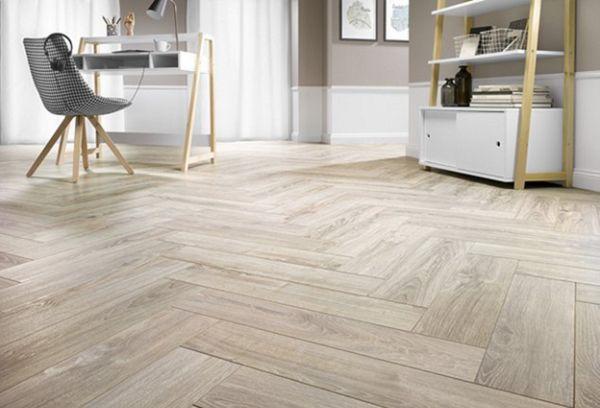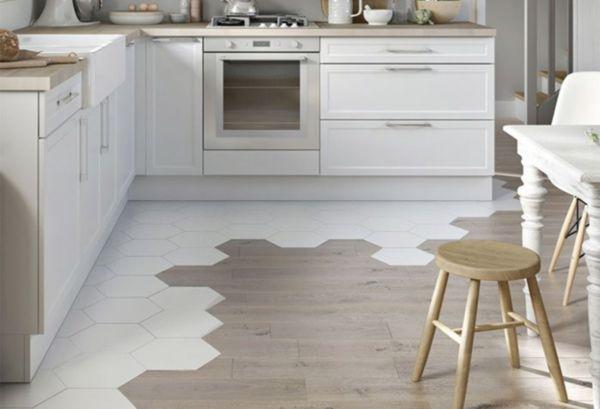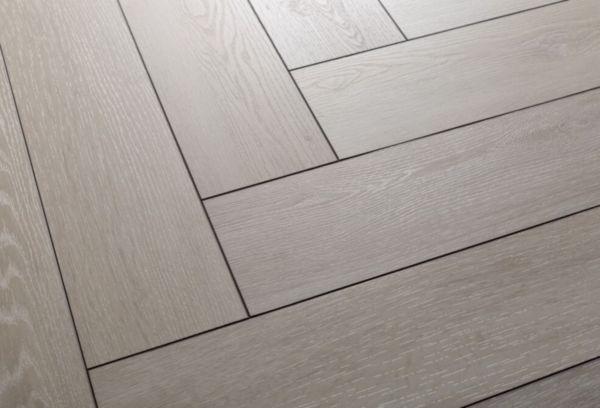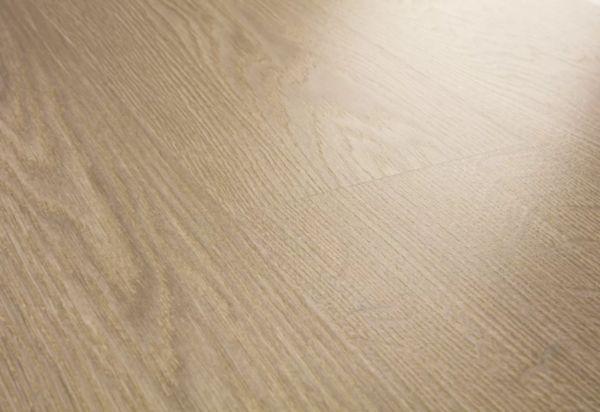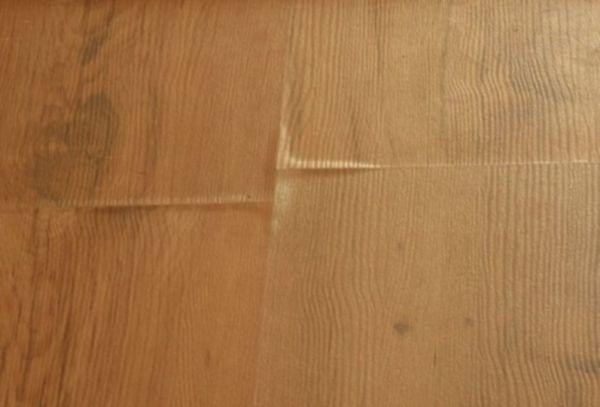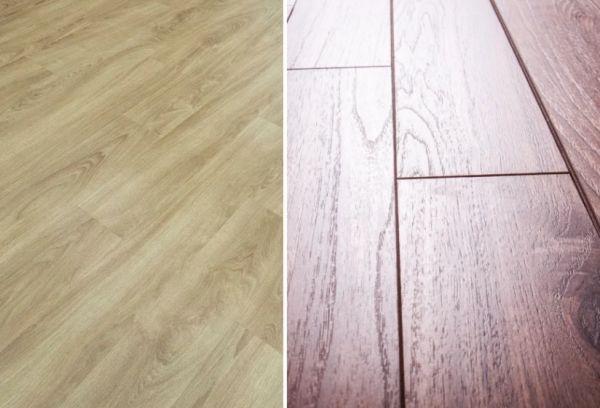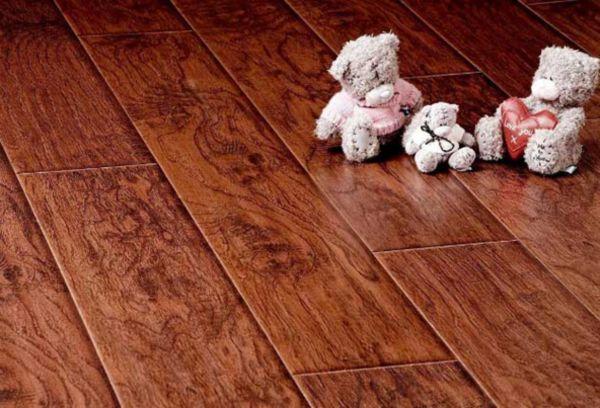Choose a laminate with or without chamfer – features and differences?
Content:
The emerging fashion for floor coverings “like wood floors” and “like tiles” makes people doubt whether to choose a beautiful laminate with or without a bevel? Which one is better, more practical, and more affordable? Most often, consumer hesitations are associated with the belief that dust, small debris, and water can accumulate in the recesses. We invite you to learn more about the materials, compare them, and debunk one myth.
What is beveled laminate?
In simple terms, a chamfer is a cut on the edge of a lock. There are cuts on two or four sides of the plank. This produces a different effect when styling. If there are two beveled edges, you can imitate a ship's plank. Example in the photo:
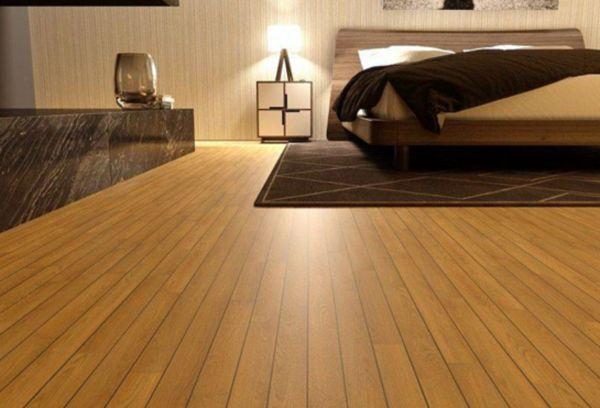
Laminate with a chamfer when assembled makes the coating textured and voluminous. You can examine each plank. This is a trend today.
Laminate floors are much cheaper than parquet, but are not inferior to it in appearance and technical characteristics. In 2021, rustic flooring is at the peak of fashion, with slats with pronounced patterns and textures that make the interior more comfortable, interesting and solid. Hungarian Christmas tree:
Combination with tiles:
The chamfer on the laminate is created using milling equipment.The edge of the plank is cut off and then covered with a moisture-proofing compound. There are also more expensive options, fully laminated. Their beveled edge is obtained by rolling. In this case, the recess is U-shaped. The lamellas differ from each other:
- Chamfer depth: 1 mm, 2 mm or 3 mm.
- Chamfer shape: V or U.
Advantages and disadvantages
Models with bevels gave designers new opportunities. They have undoubted advantages (not only of an aesthetic nature):
- They emphasize the drawing, make it voluminous and realistic.
- Hides uneven floors.
- Masks defects in joints.
So, for example, if some lamella bulges around the edges, it will not be so noticeable. The recess will become less deep, but the floor will remain visually flat. The same thing will happen when the planks diverge - the cracks will appear in the shadow of the recesses. What is true is that this will negatively affect the further operation of the coating.
Objectively, there are few disadvantages to chamfered laminate, or rather one – the high price of high-quality material.
Cheaper options can be problematic. They often have the following disadvantages:
- low protection from moisture at the edges;
- accumulation of dust, lint and dirt in crevices.
The edges of the planks can be treated with hydrophobic paint, acrylic, or laminated. Accordingly, protection from moisture depends on this. The worst option is to paint it. Gradually, during the cleaning process, it wears off, and the slats lose their protection from moisture. In this case, the surface on the cuts can fluff and catch hairs and other small debris.
As for the difficulty of caring for laminate with a chamfer, this is nothing more than a myth. The recesses are too small and are easy to clean from debris and dust. The exception is fleecy, damaged sections.
What do you need to know about laminate without chamfer?
Laminate without chamfer is smooth and even. It was the first to appear on the market. When installed correctly, the planks form a smooth, seamless coating. The joints are not visible either in daylight or in electric light.
Laminate floors without chamfer are a classic. They look good in any color. The most impressive is considered to be a glossy board, emphasizing the smoothness and integrity of the surface.
Advantages and disadvantages
Laminate without bevel is still the most common, so its advantages and disadvantages are well studied. Pros:
- Can be installed in any room, including with high humidity: in the toilet, bathroom, kitchen (aqua type). Water does not stagnate in the recesses.
- The smooth floor is easy to clean. Debris and dust are clearly visible, they do not accumulate, they are quickly collected with a broom, vacuum cleaner or just a rag.
- The entire area is subjected to uniform pressure, and therefore this flooring is considered more durable.
Disadvantage of bevelless laminate:
- Any irregularities in geometry are clearly visible on the coating. If there is swelling, installation errors or surface preparation, the laminate loses its attractiveness and requires repair.
Various defects are especially noticeable on light-colored laminate. Example in the photo:
What is the difference between them?
Laminate with a chamfer has a beveled edge, without a chamfer - the same thickness throughout. This obvious difference is visible to the naked eye. Photo:
This is where the difference comes from:
- In visual effect. After installation, a laminate with a chamfer gives a realistic relief imitation of a board or tile; non-chamfered coatings are smooth.
- In price. Creating a chamfer requires additional costs, so this laminate is always more expensive.
- The ability to accumulate moisture. Water takes longer to dry in depressions than on a flat surface.Accordingly, the risk of its destructive action increases.
Installation of both types of laminate is the same. The floor must be level, technological seams along the perimeter of the walls must be observed, and the locks must be well latched and taped.
Comparison in the table
In terms of operational and technical characteristics, laminate with and without chamfer are approximately equal.
For clarity, here is a table with characteristics, advantages and disadvantages:
| Laminate with bevel | Laminate without chamfer | |
| Peculiarity | Relief floor: V-shaped or U-shaped notch where the planks meet | Smooth floor: the planks fit together without visible seams, forming a seamless surface |
| Preparing the floor for installation | Moderately difficult. Permissible height differences – up to 4 mm every 2 m | Complex. A height difference of up to 2 mm every 2 m is allowed |
| Choice of shades | Wide | Wide |
| Slat thickness | 10-14 mm (thinner is not recommended) | 7-14 mm |
| Class | 31-34 | 31-34 |
| Moisture protection, strength, wear resistance | Depends on class | Depends on class |
| Ease of care | It is necessary to carefully wipe away moisture in the recesses | Yes |
| Main advantage | Visual effect, masking imperfections | Suitable for all types of premises |
| Main disadvantage | High price for quality material | All defects are clearly visible |
| Price | 1000-2000 rub./m2 | 500-1000 rub./m2 |
Which is better to choose?
In general, the choice between laminate with and without bevel is a matter of taste. According to their characteristics, the materials may be identical.
It is better to choose a laminate with a chamfer:
- Based on aesthetic considerations. This kind of flooring is in fashion today, it always looks neat, and helps to visually expand (lengthen) the room.
- For living rooms: living room, bedroom. These rooms are usually dry and clean, and caring for the textured floor is easy.
An even and smooth coating is more suitable:
- For those who visually like a smooth floor.
- For rooms with high humidity and dirt: kitchens, hallways, bathrooms.
The most successful is considered to be a laminate with a beveled oak color, light brown and dark, almost black. Firstly, defects are least noticeable on dark shades. Secondly, such a floor looks as voluminous as possible.
Which is better according to reviews?
People's opinions about the presence of a chamfer on laminate differ: some believe that it significantly improves the appearance and practicality of the floor covering, while others find more disadvantages than advantages in it. But still:
There are more supporters of chamfering.
Reviews:
- Dmitry Zheleznikov: “I regret that I bought laminate without a chamfer. We took the cheapest one from Leroy. The joints are already swollen here and there, a little, but in the light it’s quite noticeable. If there had been a chamfer, this would not have happened.
- Alexei: “Without a chamfer, it’s a complete collective farm, my opinion. I took a good, expensive laminate with a u-shaped microbevel. The bevels are laminated, not painted. And the locks are already coated at the factory. It’s beautiful, no cracks are visible, no dirt gets clogged. There are no cracks yet, ugh ugh, I checked with my fingernail.”
- Elena D.: “For 20 years the laminate has been laying without a chamfer, I think it’s Kronoplast. Everything is fine, even though I wash it several times a day (due to health reasons). The only drawback is that you can see footprints if you walk without socks.”
- Alex: “I’ve had cheap Chinese laminate with a chamfer for 15 years. Withstood everything like new!”
- Andrey Rykov: “Visually I like the seam - it looks aesthetically pleasing. But my wife is categorically against chamfered laminate. Like, dust and dirt will get clogged. I tried to persuade her for a long time. After all, we don’t live in a barn, and all sorts of tests and calculations are carried out.Everything comes out of the recesses perfectly, and the moisture evaporates, but in the micro-cracks, on the contrary, it is buried for a long time. Persuaded. Tomorrow we’re going to buy it, I took mine!”
- Alexander Nechaenko: “I read the reviews and I’m amazed. How many people believe in a magical bevel - it’s more beautiful, more practical, and what else? Marketing works! In fact, the chamfer is needed to reduce manufacturing defects. Even boards break off at the edges, and the difference in thickness is very noticeable. That’s why they came up with a miracle chamfer, and in order to take it, they “drew” its advantageous sides. Don't look at that! It all depends only on the junction of the edges and the quality of the material. Smaller gap = less chance of moisture penetration.”
- Pasha: “I’ve had laminate flooring at home without a chamfer for 18 years. Smooth, even, not swollen, although it was drowning. Kwik Step company.
Questions and answers
Which type of bevel is better, U or V?
The U-shape is considered more perfect. It is less susceptible to damage and swelling, because in most cases it is laminated and does not have protrusions that a furniture leg or something else can get caught on.
Is it true that chamfered laminate is less durable?
No. The chamfer is applied to a board with a thickness of 10-12 mm, and its depth does not exceed 3 mm. In this ratio, the strength of the floor covering does not suffer. Thinner strips are not worth buying. This is a violation of technology.
To summarize, the quality of the material and the skill of installation are of great importance. Under equal conditions, there is not much difference between laminate with and without chamfer. It makes sense to choose between them to create different effects (for example, a ship's deck) and enhance the design. It is also worth giving preference to a laminate with a chamfer for high traffic and heavy loads on the floor. It doesn't show much wear and tear.Embossed coating is now in trend, but the difficulty of cleaning it is a myth.
